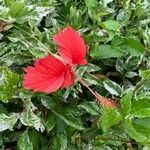Herb, annual, up to 2-3 m high, the stem simple or branched, sparsely aculeo-late, the prickles pustular-based and upturned, otherwise glabrous or with a longi-tudinal short-hairy line changing radially at each node. Leaves with slender elongate petioles, these with the same indumentum as the stem, the stipules fili-form; blade polymorphic, simple and more or less subcircular to usually 3-to 5(-7)-palmatifid, the lobes elliptic to linear-ovate and acute or acuminate, serrate at the margins, up to 15 cm long, glabrate or with few minute prickles on the veins. Flowers axillary, solitary or in racemiform terminal inflorescences by reduc-tion of the uppermost leaves, subsessile or short-pedicellate, the pedicel stout, up to 5 mm long and aculeolate; epicalyx of 7-10 bractlets, these linear, channelled, united at the base and adnate to the base of the calyx, flattened and slightly dilated at the apex, usually with a small tooth-like appendage on the inner surface below the apex, 8-15 mm long, setose especially along the margins, the setae hyaline and pustular-based; calyx cupuliform, lobed to below the middle, 15-25 mm long, up to 30 mm in fruit, scarious, greenish or whitish, setose, the lobes long-acuminate, 3-nerved, eglandular; petals cuneate-obovate, rounded at the apex, 3.5-8 cm long, yellow or red, with crimson basal spots; staminal tube about 1 as long as the corolla, antheriferous on most of its length, the filaments mostly paired; style about as long as the staminal tube, the stigmas densely fimbrillate. Capsule surrounded by the persistent epicalyx and calyx, ovoid, acuminate, 15-20 mm long, densely ap-pressed-setose, the valves ligneous; seeds subreniform-angulate, 3-5 mm long, very minutely appressed-squamose.
A shrub. It keeps growing from year to year. It grows from 0.5-2 m tall. It can be upright or lie over. The leaf stalk is 3-11 cm long and spiny. The leaf blade is wide and often with 3 lobes on the lower stem and 3-5 lobes arranged like fingers on a hand higher up the stem. There are teeth around the edge. Leaves are 5-12 cm long by 4-15 cm wide. The flowers occur singly in the axils of leaves. Flowers are purple or red. The fruit is a round capsule about 15 mm across. It has flat long spines. The seeds are triangle shaped. They are brown and about 4 mm across.

